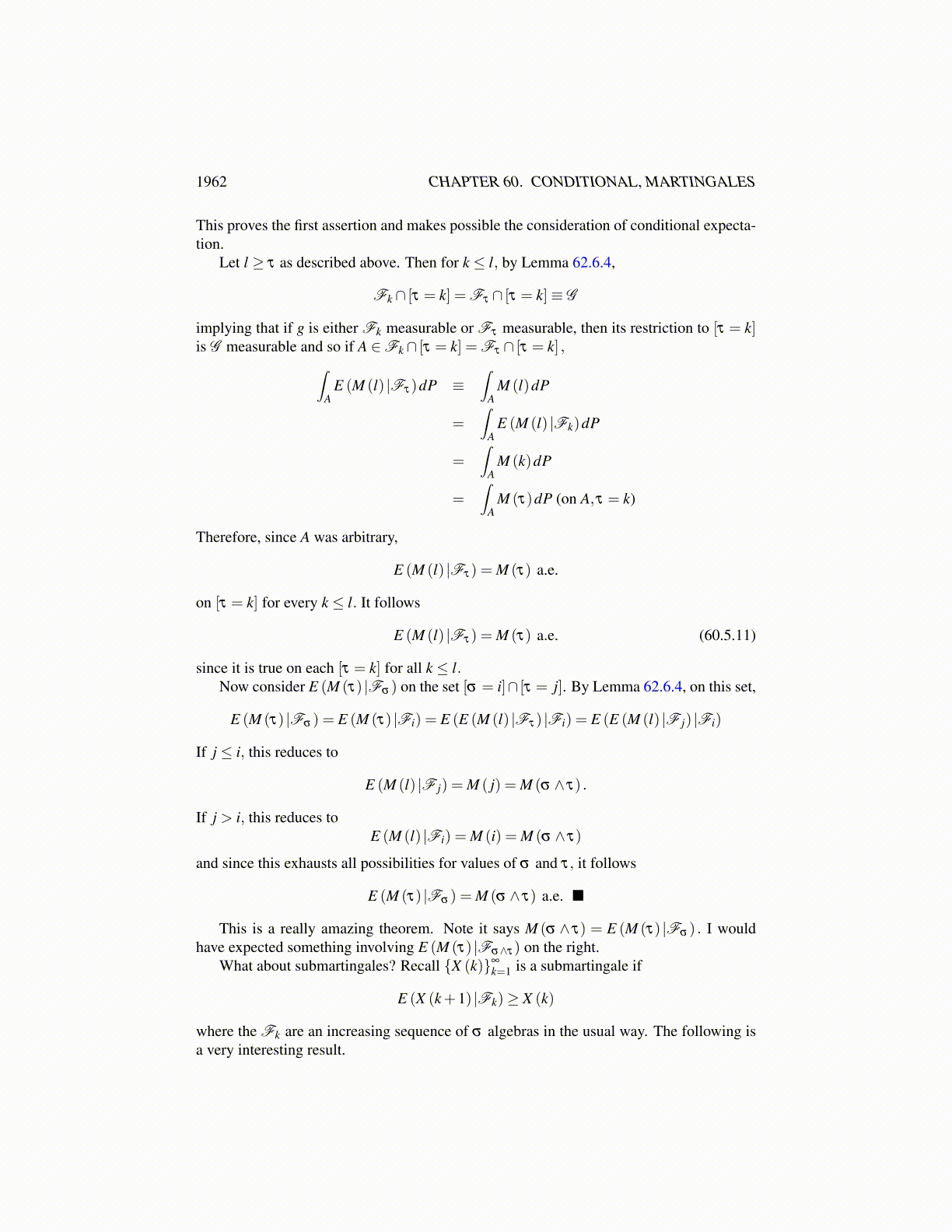
1962 CHAPTER 60. CONDITIONAL, MARTINGALES
for all k. This will be done if I can show
A∩ [σ ≤ j]∩ [τ ≤ k] ∈Fk
for each j ≤ k because
∪ j≤kA∩ [σ ≤ j]∩ [τ ≤ k] = A∩ [σ ≤ τ]∩ [τ ≤ k]
However, since A ∈Fσ , it follows A∩ [σ ≤ j] ∈F j ⊆Fk for each j≤ k and [τ ≤ k] ∈Fkand so this has shown what I wanted to show, A∩ [σ ≤ τ] ∈Fτ .
Now replace the stopping time, τ with the stopping time τ ∧σ in what was just shown.Note
[τ ∧σ ≤ n] = [τ ≤ n]∪ [σ ≤ n] ∈Fn
so τ ∧σ really is a stopping time. This yields
A∩ [σ ≤ τ ∧σ ] ∈Fτ∧σ
However the left side equals A∩ [σ ≤ τ] . Thus
A∩ [σ ≤ τ] ∈Fτ∧σ
This has shown the first part of 2.), Fσ ∩ [σ ≤ τ] ⊆ Fτ∧σ . Now 60.5.10 implies if A ∈Fσ∧τ ,
A = A∩all of Ω︷ ︸︸ ︷
[σ ∧ τ ≤ τ] ∈Fτ
and so Fσ∧τ ⊆Fτ . Similarly, Fσ∧τ ⊆Fσ which shows
Fσ∧τ ⊆Fτ ∩Fσ .
Next let A ∈Fτ ∩Fσ . Then is it in Fσ∧τ ? Is A∩ [σ ∧ τ ≤ k] ∈Fk? Of course this is sobecause
A∩ [σ ∧ τ ≤ k] = A∩ ([σ ≤ k]∪ [τ ≤ k])
= (A∩ [σ ≤ k])∪ (A∩ [τ ≤ k]) ∈Fk
since both σ ,τ are stopping times. This proves part 2.).Now consider part 3.). Note that [τ = k] is in both Fk and Fτ . This is because τ is a
stopping time so it is in Fk. Why is it in Fτ ? Is [τ = k]∩ [τ ≤ j] ∈F j for all j? If j < k,then the intersection is /0 ∈F j. If j ≥ k, then the intersection reduces to [τ = k] and this isin Fk ⊆F j so yes, [τ = k] is in both Fk and Fτ .
Let A ∈Fk. I need to show
Fτ ∩ [τ = k] = Fk ∩ [τ = k]
where G∩ [τ = k] means all sets of the form A∩ [τ = k] where A ∈ G . Let A ∈Fτ . Then
A∩ [τ = k] = (A∩ [τ ≤ k])\ (A∩ [τ ≤ k−1]) ∈Fk